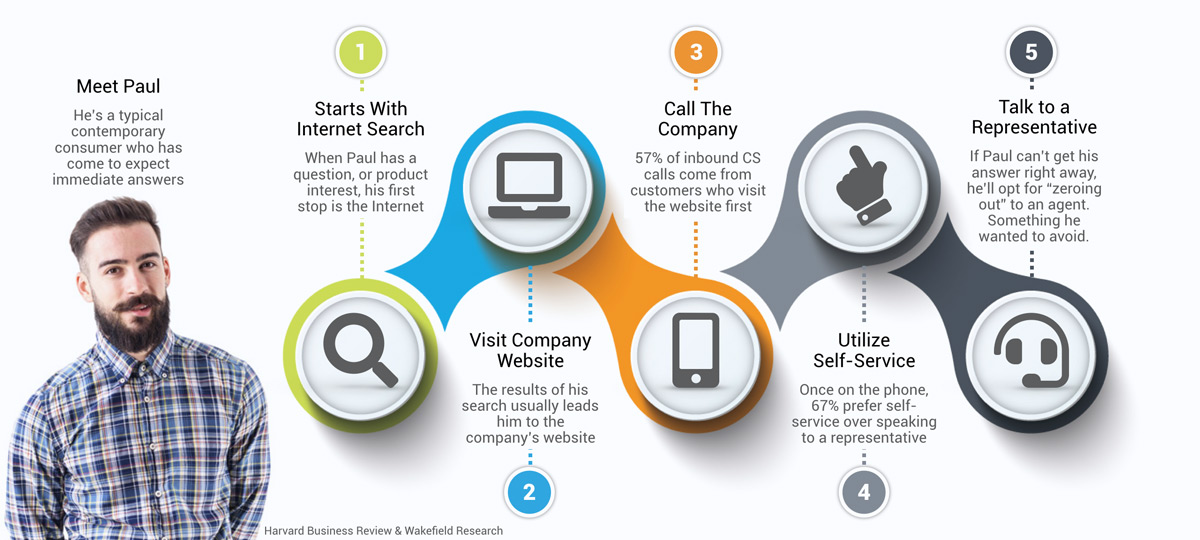Your IVR is an important, if not critical, component of your customers’ journey. It’s a crucial step in the customer experience that can either end their journey with abrupt disappointment or propel the journey into a deep relationship with your company. But we see too many companies treating their IVR as a mere utility, a means of saving resources and deflecting calls with little or no strategy. And in some unfortunate cases (unfortunate for your customers), the IVR is built and maintained by your IT department. Now, I have nothing against your IT people; they’re hardworking technologists who often don’t get the credit they deserve. But if you wouldn’t have your IT department map your customer journeys, then they shouldn’t be in charge of your IVR.
When developing an IVR, an IT team will typically review one or more of the drag-and-drop IVR builders on the market. They’ll pick the product that best fits within their workflow, and begin with a default call flow template that best fits the need. From there, stock functions are added to the call flow to build the desired automation application. The job gets done, and hopefully, customers are satisfied. But today, companies differentiate on customer experience; customers who are simply “satisfied” is not enough.
The Customer Journey, Condensed
 In our Automation Game Plan e-book, we look at an ultra-high-level representation of a contemporary customer journey, shown above. From studies by Harvard Business Review and Wakefield Research, we learn that the typical customer journey begins on your website. Most importantly, 57% of inbound customer service calls come from customers who went to your site first, looking for answers before they call. So at this point, their likely journey is one of two paths, they didn’t get the needed answer, or they want a deeper relationship. And they either become champions or detractors of your brand, depending on what happens next.
In our Automation Game Plan e-book, we look at an ultra-high-level representation of a contemporary customer journey, shown above. From studies by Harvard Business Review and Wakefield Research, we learn that the typical customer journey begins on your website. Most importantly, 57% of inbound customer service calls come from customers who went to your site first, looking for answers before they call. So at this point, their likely journey is one of two paths, they didn’t get the needed answer, or they want a deeper relationship. And they either become champions or detractors of your brand, depending on what happens next.
Turn Your IVR Into a CX Game Changer.
It’s not enough to “satisfy” your customers. And with more and more companies striving to “delight” their customers, every touch-point matters. Your IVR is a pivotal touch-point that has the ability to surprise your customers with an unexpected level of service. So it’s important not to turn it over to someone who has no stake in customer service, retention, and NPS surveys. You need a professionally crafted Game-Changing IVR.
A Game-Changing IVR knows your customers through a connection to your data. It answers questions, resolves problems, introduces new offers, directs callers to the right representative, accepts secure payments, and empowers your customers with rapid self-service. It’s a customer-first approach to delivering a surprising level of service.
Additional Reading
When you’re reconsidering your IVR strategy to put it into the hands of customer service, there are a few things you need to consider to truly surprise your customers with amazing service.
In our article, Customer Service Automation: The Little Things Matter, we help you understand some of the unexpected small things that can help your IVR be the CX Game Changer you need.
With Why Today’s Customers Expect Self-Serve Options, we show you how the tide of conventional wisdom has shifted, as more and more consumers prefer self-serve options when calling companies.
We’ve reflected on the coming trends, and wrote IVR Best Practices For 2020, to help you understand some of the most important customer service automation strategies for the coming decade.
And finally, the most-read article in our entire blog, 8 Best Practices To Deliver Delightful IVR Experiences, gives you the core tactics for your IVR game plan.
Every Journey Needs A Compass
Our Managed CPaaS, the Compass Automation Platform, is the ideal foundation for Game-Changing CX. It’s our rapid development platform for complex voice automation applications, from IVR’s that know your customer, to secure payments by phone and text.